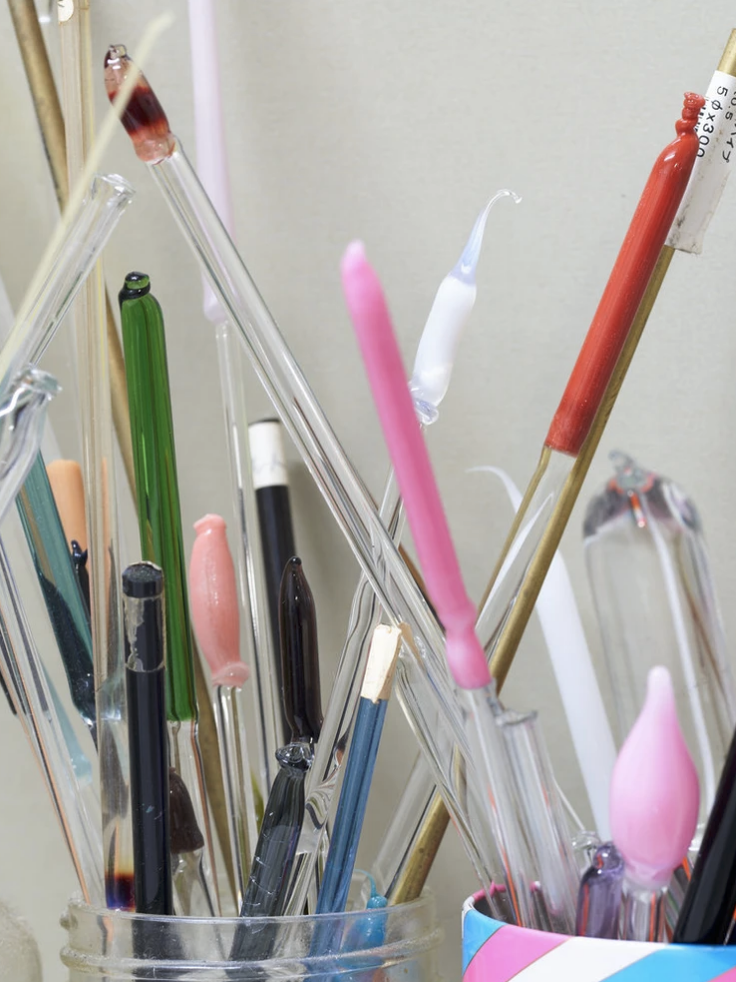A material called glass that is like a solid and close to a liquid, and can change freely
2018.08.31
Glass, rattan, mother-of-pearl... SIRI SIRI jewelry is made from materials found in our daily lives. In the series "A Journey to Materials," we delve into perspectives that create new value while uncovering the origins and characteristics of materials.
-
SIRI Glass is one of the most important materials in SIRI products. It is said that mankind began to use glass around the time of the Mesopotamian civilization, 3,500 to 4,000 years ago. It is said that when a merchant accidentally made a fire with a bag of soda ash on the beach, the beach and the soda ash turned into a clean, transparent stone. It is said that it was used as a material for high-class ornaments. After that, the production method became popular in Japan around the end of the Edo period. It is said that it was after the war that it came to be used habitually as a window that is close to the house.
Even if you see it with your eyes and touch it with your hands and recognize it as a solid, it is also a mysterious material that does not fit the scientific definition of a solid. A solid is a crystal that has a structure in which molecules are arranged in an orderly manner. Liquids, on the other hand, refer to amorphous substances in which molecules are randomly arranged and move around freely. In other words, the interior of glass is a structure in which atoms are randomly packed, and the atoms move slowly over tens of thousands of years. That's why it's scientifically treated as something close to a liquid. The reason glass is transparent also stems from the irregularities in its structure. Light does not scatter, and the main component, silica sand (silicon dioxide), does not absorb light, so it looks colorless and transparent like water.

So what exactly is glass? In the short span of human life, it appears to be stationary, but it is actually a material that moves slightly like a liquid. Thinking about using such glass as lenses, windows, bottles, vessels, etc. that let light pass through in our daily lives, or wearing it as jewelry, makes us feel strange. Witnessing Mutsumi Kashida, one of the glass craftsmen who work on SIRI SIRI's products, skillfully handling glass, you will realize that it is a material that is almost liquid. The characteristic of boiling when too much heat is applied also seems to represent the liquidity of glass.
Delicate jewelry created only with fire and glass

The heat-resistant glass used in SIRI SIRI jewelry has a melting point of about 600 degrees. The shaping, cutting, and joining are all done over the fire of a gas burner. The tools used are also relatively simple, such as tweezers that shape a glass core rod called a ponte. When melted glass is combined, it naturally fuses, so no glue is required. Transparent glass rods and glass tubes transform into jewelry. A glass tube with linear unevenness on the inside is held over the burner and turned slowly so that the entire surface is exposed to fire so that it does not turn into a liquid and fall. The flame is a flame reaction, changing from blue to red.
"Unexpectedly, it doesn't collapse," says Mr. Kashida, but it is difficult to handle glass freely without training for at least three years. Glass, which goes back and forth between solid and liquid on fire, seems to be a material that does not listen to what you say. The heated and softened glass tube becomes thinner by pulling on both sides, and is shaped according to the design of SIRI SIRI's jewelry. To make it rounder, just blow a little bit of air into it with a blowout stick.
Whether or not you can draw a smooth and beautiful curve depends on the craftsman's sense. In the hands of a craftsman who treats glass like a magician, it looks as if the glass sculpture is being completed in the air. Mr. Kashida says that the technique "may be similar to cooking." Originally he was a chef. In the sense that simple ingredients are cooked over a fire, cooking and glass crafts may indeed be closely related.
Glass is completed by being heated repeatedly and then cooling and hardening, but it also has the weakness of being vulnerable to temperature changes and easily breaking. That is why the final process needs to be done carefully, says Mr. Kashida. “The surface of the glass swells when it warms up, but the core is still cold, so the difference in temperature can cause the glass to crack. and it will be completed.”
Glass, which has both a free-for-all strength and a beautiful delicacy, is transformed into the form we want through the careful handiwork of craftsmen. Although glass has been touched by humans since ancient times, many aspects of glass still remain unclear. It was as if I had grasped that quality for a moment, and I was made to realize once again that it was full of elusive charm like flowing liquid.
Written by Tomoko Ogawa
Photo Go Itami


